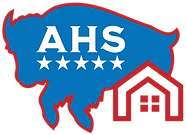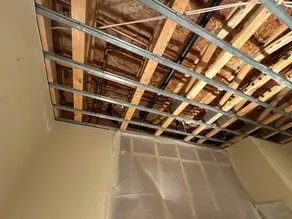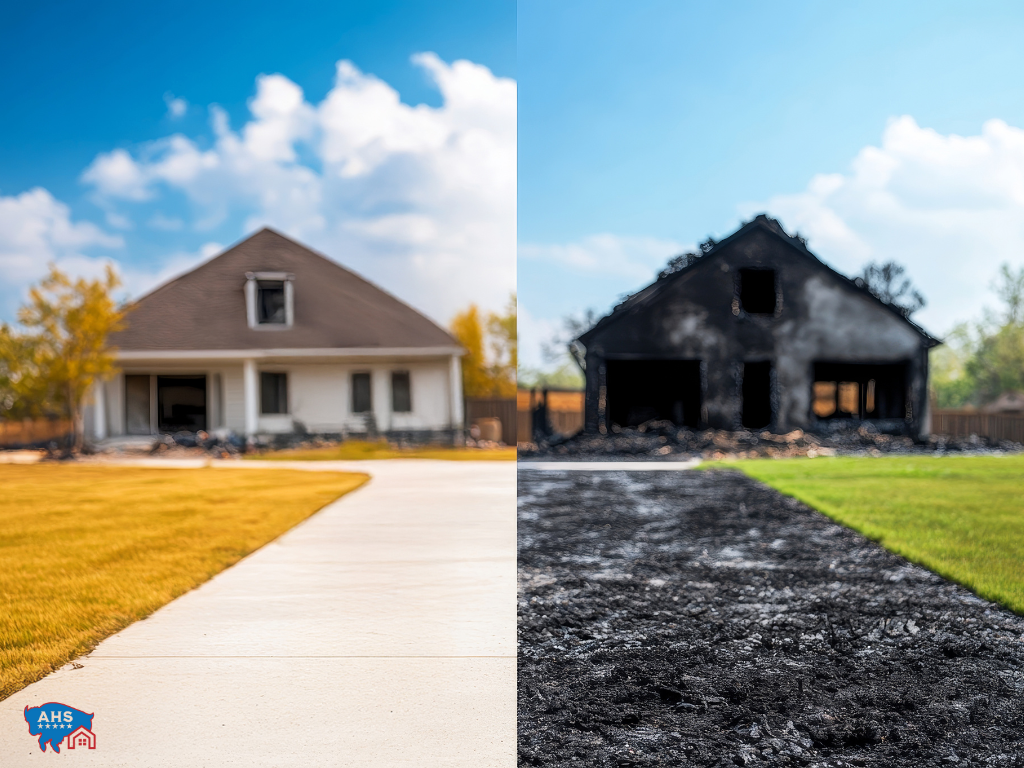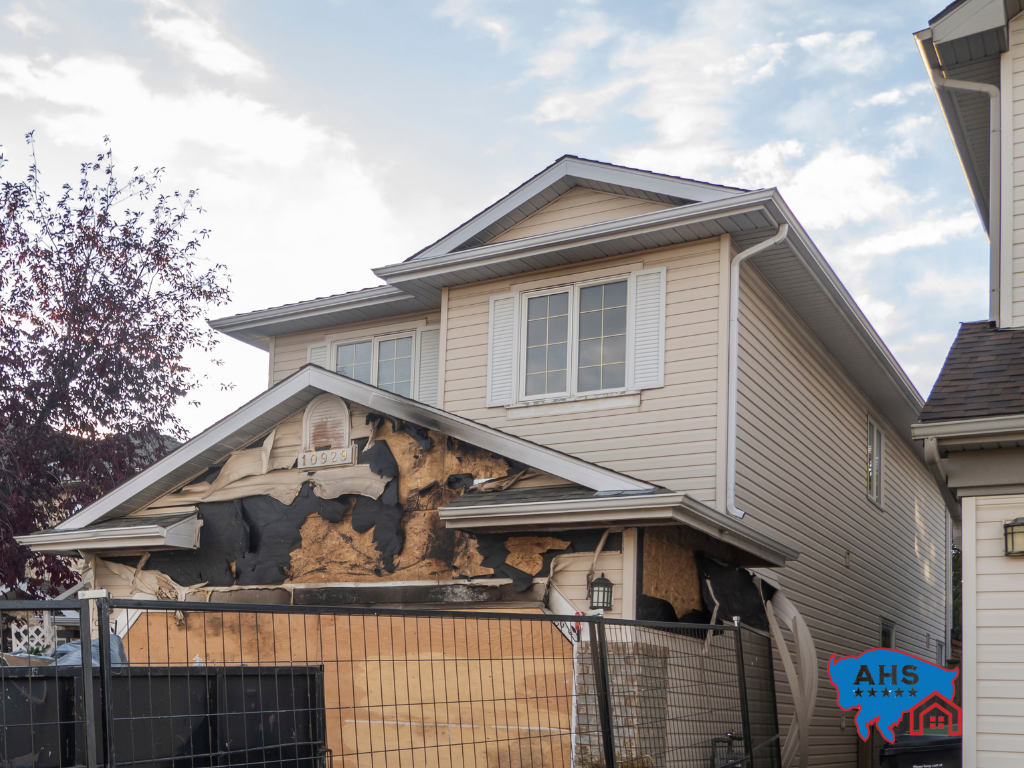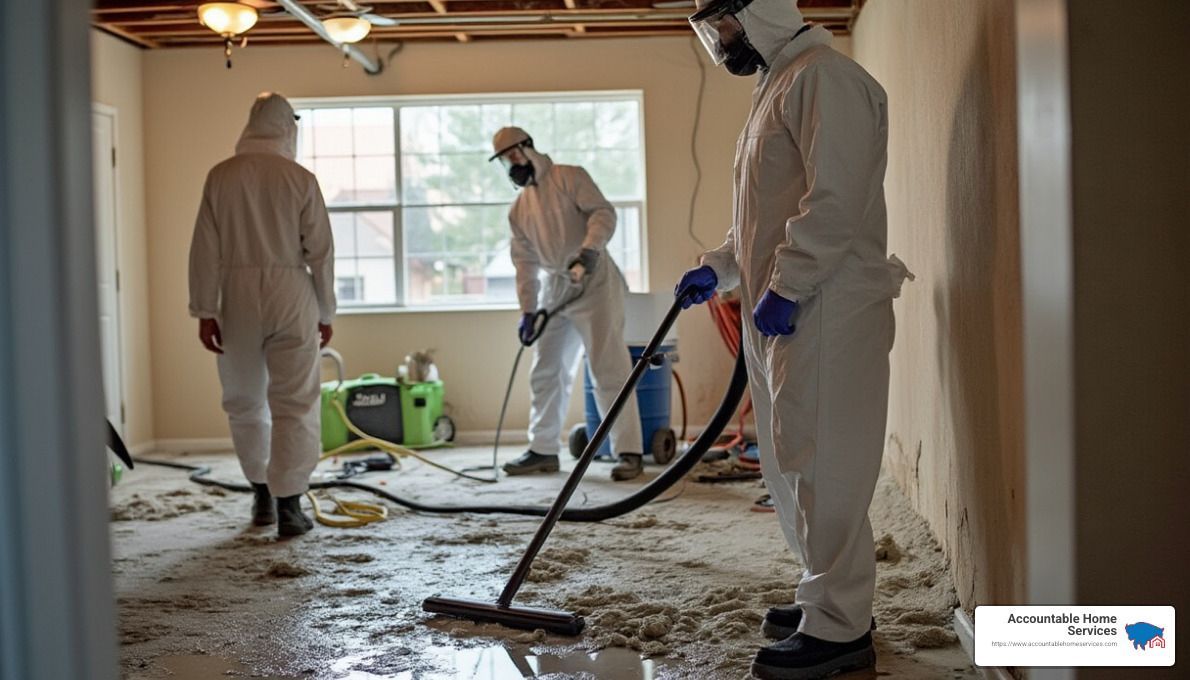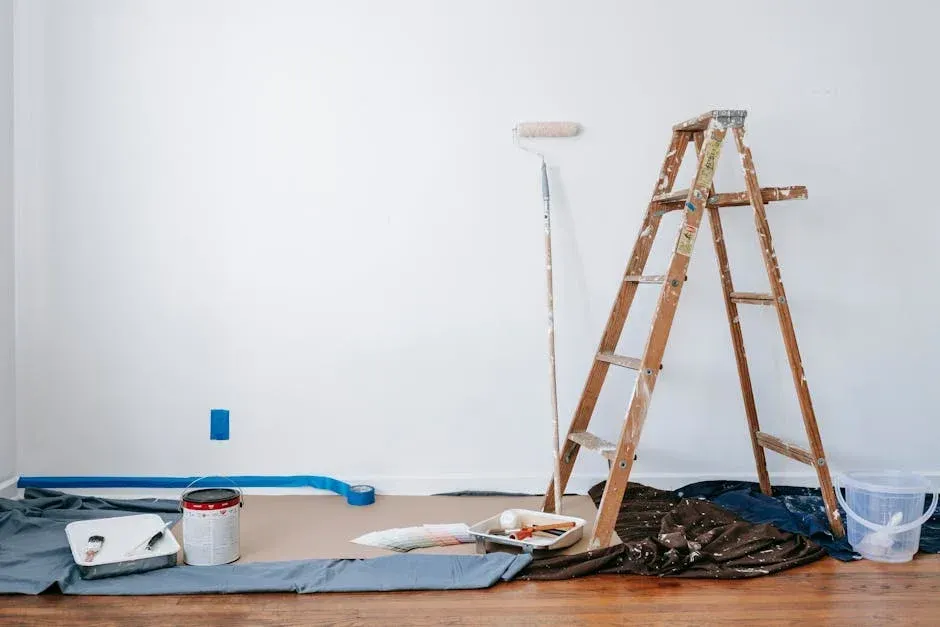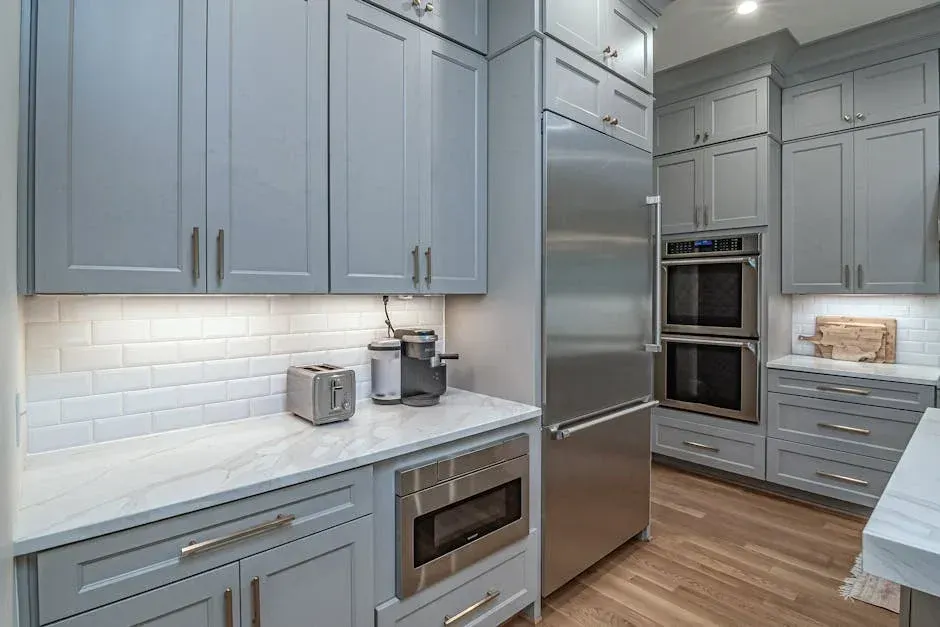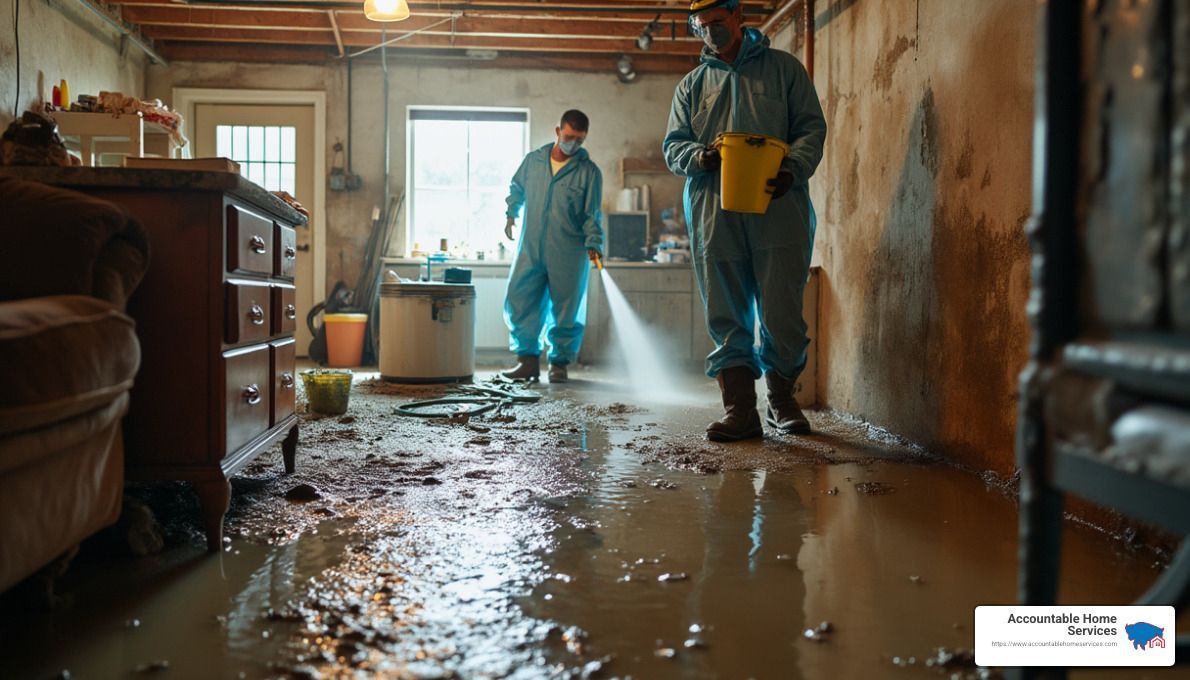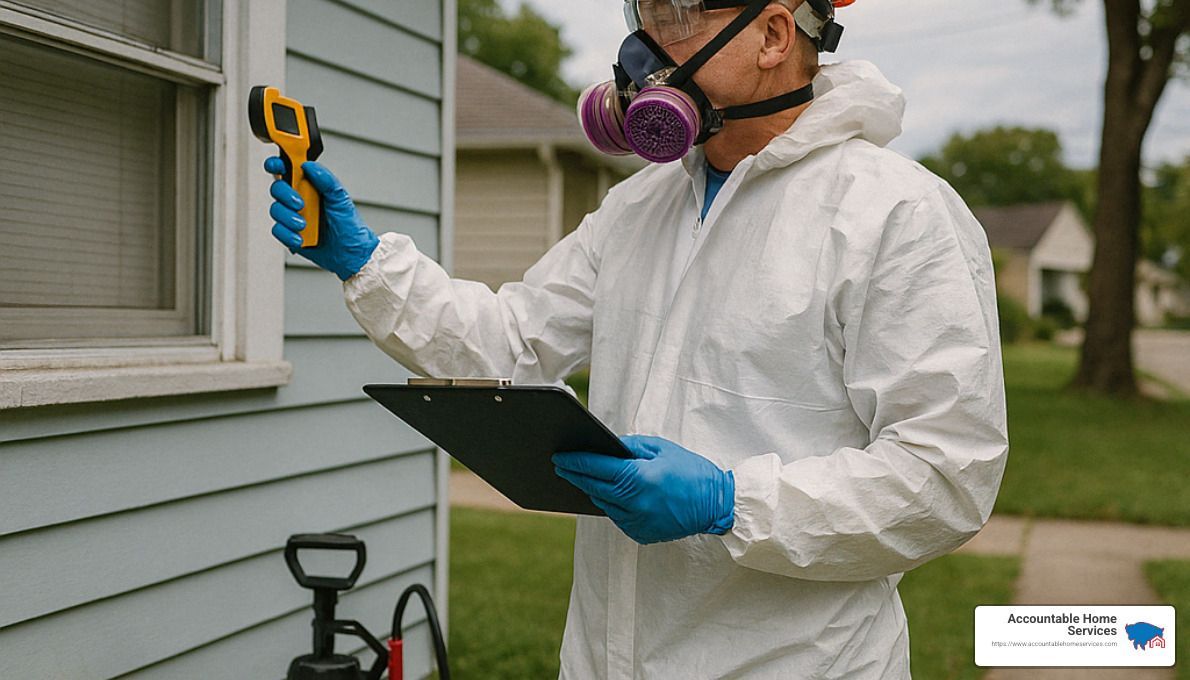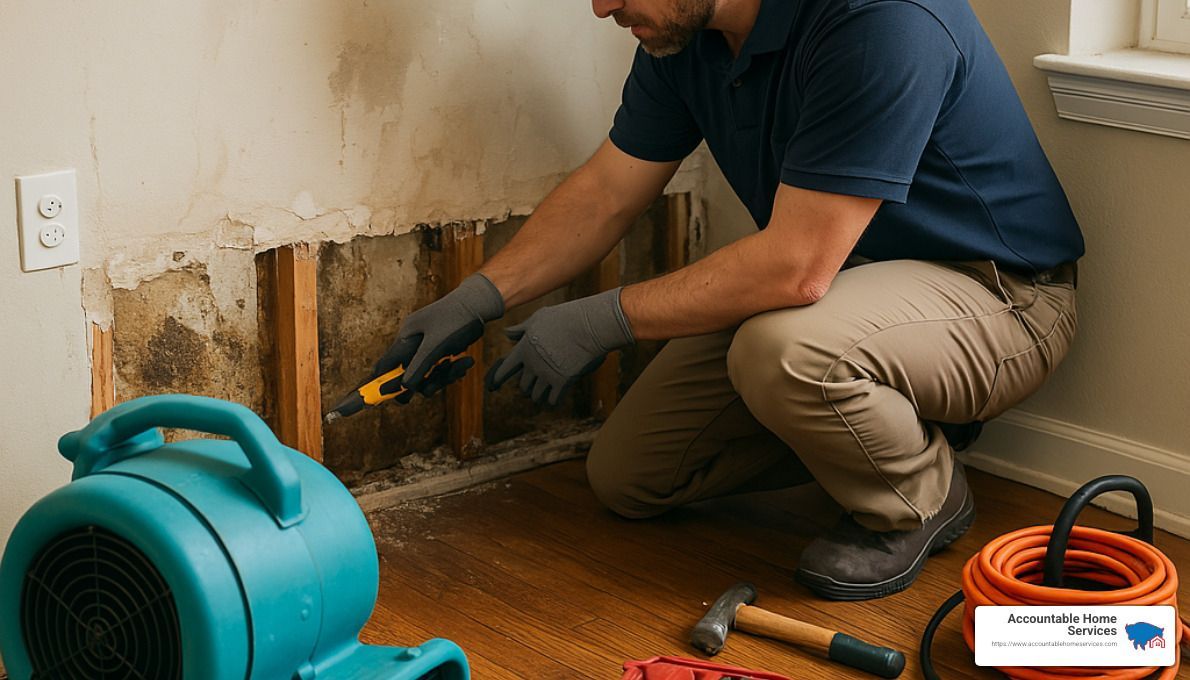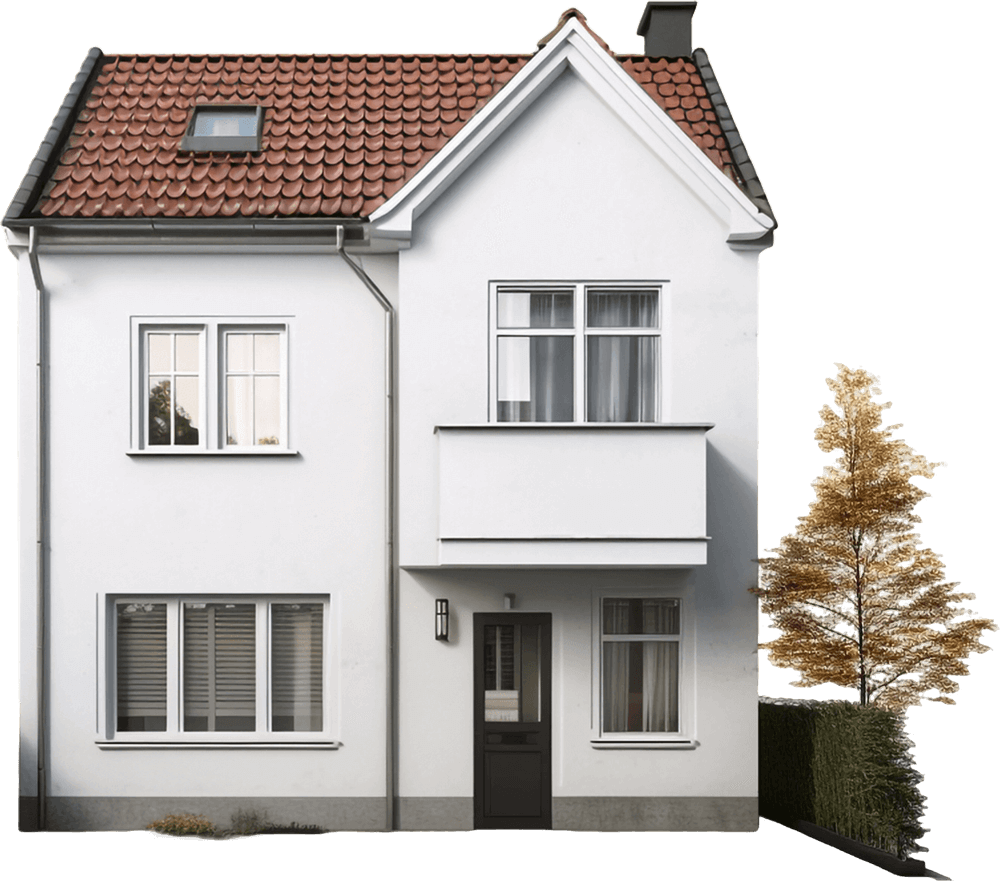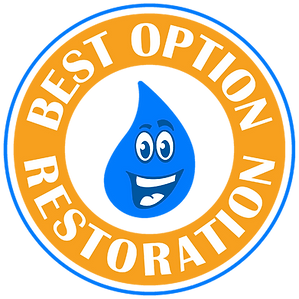Blog
When Disaster Strikes: Understanding Fire Damage Repair in Denver
The moment you see flames engulfing part of your home is something no Denver homeowner ever forgets. As the smoke clears and firefighters leave, you're left facing the aftermath—charred walls, water-soaked floors, and that unmistakable smell that seems to permeate everything.
I'm Mike Martinez, owner of Accountable Home Services, and I've guided hundreds of families through the Denver fire damage repair process. What I've learned is that restoration isn't just about rebuilding walls—it's about helping people rebuild their lives and sense of security.
When fire strikes a Denver home, time becomes your most precious resource. Our dry Colorado climate presents unique challenges—low humidity and seasonal winds can not only accelerate fire spread but also complicate the restoration process afterward. That's why professional response within hours, not days, makes all the difference.
The Denver Fire Department responds to over 1,000 structure fires each year, with most home fires stemming from three main culprits: cooking accidents, electrical issues, and heating equipment. These common scenarios account for more than 60% of all residential fire incidents in our area.
What many homeowners don't realize is that fire damage extends far beyond what's visibly burned. Smoke particles infiltrate every corner of your home, soot silently corrodes metal surfaces, and the water used to extinguish flames creates its own set of problems. Without proper professional intervention, these hidden damages can lead to structural weakening, persistent odors, and potential health hazards for your family.
Most Denver fire damage repair services provide comprehensive solutions that take you from emergency board-up through complete reconstruction. Response times typically range from 1-2 hours, with costs varying between $3,000 for minor incidents to $30,000+ for extensive damage. While small repairs might be completed in just 1-2 weeks, more substantial restoration projects may require several months to finish properly. The good news? Most reputable restoration companies offer direct insurance billing to ease your financial burden during this stressful time.
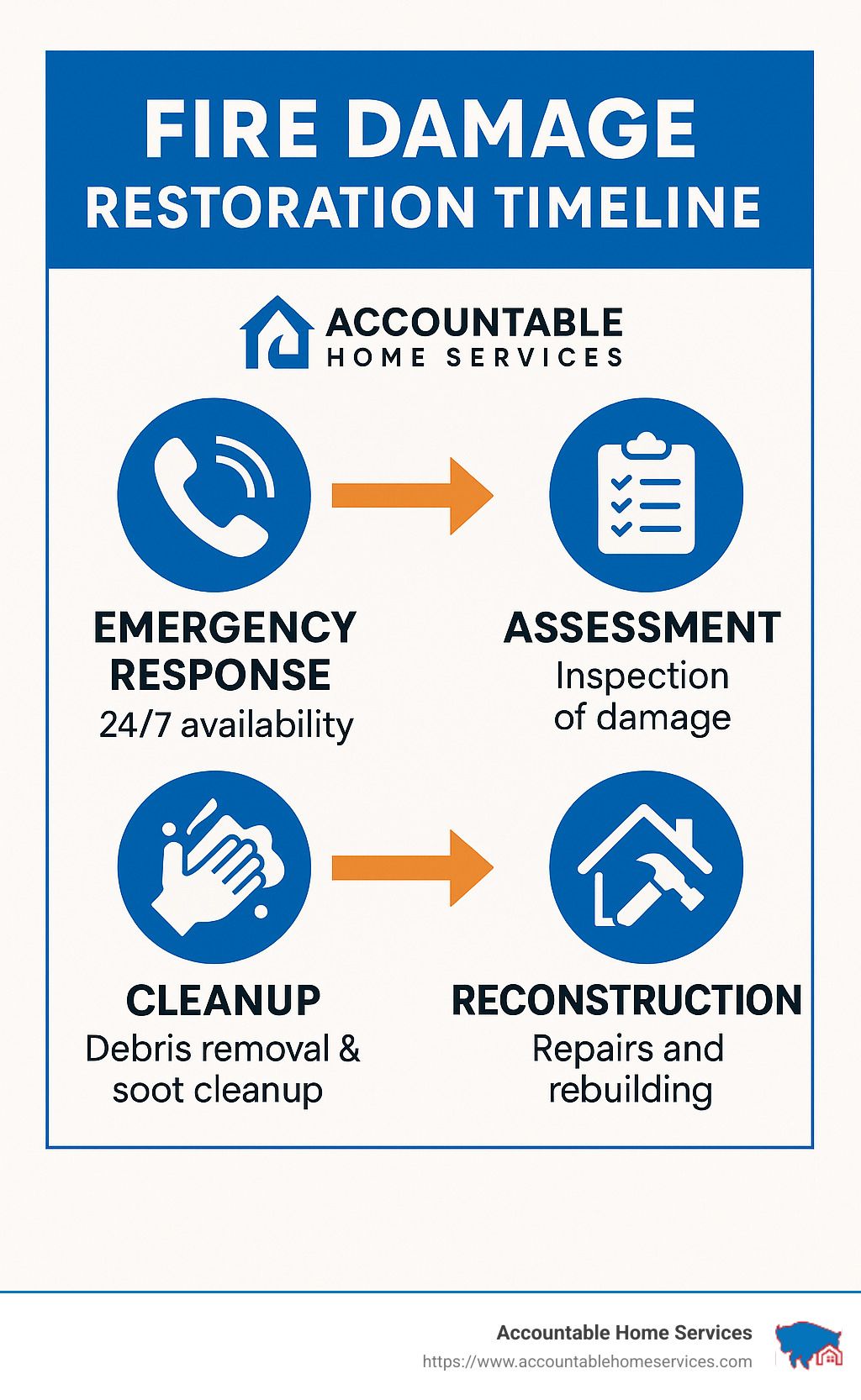
At Accountable Home Services, we've seen how overwhelming fire damage can be for Denver families. That's why we approach each restoration not just as a construction project, but as a partnership to restore both your property and your peace of mind. When disaster strikes, having a trusted local expert by your side makes all the difference in turning a devastating event into the beginning of a recovery journey.
What Is Fire Damage Repair and Why It Matters in Denver
When flames tear through a Denver home, they leave behind more than just charred walls. Fire damage repair is the complete process of bringing your property back to life after flames, smoke, soot, and firefighting water have taken their toll. And in Denver, this restoration process takes on special significance.
Our Mile High City presents unique challenges when it comes to fires. Denver's semi-arid climate is practically a recipe for fire trouble – low humidity, seasonal winds that can gust unexpectedly, and bone-dry conditions that can turn a tiny spark into a serious situation in minutes, not hours.
I've seen how our Denver environment affects fire behavior. A small kitchen fire that might stay contained in a more humid climate can race through a Denver home alarmingly fast. And for those living in neighborhoods along our wildland-urban interface, the threat multiplies during wildfire season when urban and forest fires can interact in dangerous ways.
"The combination of Denver's dry climate and seasonal winds can accelerate the spread of fire and smoke, increasing the risk of extensive property damage if not addressed quickly," explains our senior restoration technician.
Beyond the immediate crisis, fire damage creates lasting problems that many homeowners don't initially recognize:
Property value impacts can be severe – unaddressed fire damage dramatically decreases your home's market value in Denver's competitive real estate market.
Structural integrity issues often lurk beneath the surface, where fire may have weakened critical support elements.
Health concerns persist long after flames are extinguished – lingering soot and smoke residue contain known carcinogens and respiratory irritants that can affect your family's wellbeing.
Secondary damage continues developing without proper remediation – smoke odors can stubbornly persist for years, embedding in everything from drywall to furniture.
Scientific research on smoke residue by organizations like the Red Cross confirms what restoration professionals have long known: smoke particles are insidious invaders. They penetrate deep into porous materials throughout your home – drywall, insulation, carpeting, and more. These microscopic particles aren't just smoky remnants; they contain acids, chemicals, and metals that continue damaging your property long after the fire trucks have departed.
In Denver's hot housing market, where property values continue climbing, protecting your investment through proper Denver fire damage repair isn't just about safety – it's about preserving what's likely your most valuable asset. Professional restoration ensures both visible and invisible damage is properly addressed, preventing the long-term issues that could affect your home's value and your family's health for years to come.
When fire strikes in our unique Denver environment, the path to recovery requires specialized knowledge and equipment. That's why local expertise matters when selecting restoration professionals who understand our specific climate challenges and building practices.
Most Common Causes of Fire Damage in Denver Homes & Businesses
If you've lived in Denver for any length of time, you know our beautiful city faces unique fire risks. Understanding what typically causes fires here isn't just interesting—it could save your home and family. Based on local fire department statistics and our experience in Denver fire damage repair, we've identified several recurring culprits.
Kitchen Fires (30%)
Nothing turns a peaceful evening upside down faster than a kitchen fire. As the number one cause of residential fires in Denver, cooking accidents account for nearly a third of all house fires we respond to. Unattended stovetops, grease fires that escalate in seconds, and flammable kitchen towels or paper products near heat sources are routine scenarios we encounter.
One Westminster homeowner shared her experience with us: "I stepped away from my kitchen for just two minutes while frying chicken, and when I returned, flames were reaching the cabinets. The damage spread so quickly in our dry climate that even though the fire department arrived within minutes, we needed extensive restoration throughout the first floor."
Heating Equipment (15%)
When those famous Colorado winter temperatures drop, our heating systems kick into overdrive. Unfortunately, this seasonal necessity accounts for about 15% of home fires. Malfunctioning furnaces, dirty chimneys that haven't seen maintenance in years, and space heaters placed too close to bedding or furniture become serious hazards between October and March.
Electrical Issues (15%)
Many Denver neighborhoods feature charming historic homes that weren't designed for today's electrical demands. From Capitol Hill to Washington Park, aging wiring systems struggle to keep up with modern appliances and electronics. Overloaded circuits, faulty appliances, and outdated electrical panels contribute significantly to residential fires—especially in homes built before 1980.
Smoking Materials (12%)
Despite declining smoking rates, cigarettes and other smoking materials remain a persistent fire hazard. Our dry Denver climate makes improperly extinguished cigarettes particularly dangerous, as they can smolder undetected before igniting nearby materials. We often see these fires starting on porches, patios, or in bedrooms late at night.
Candles and Open Flames (10%)
That romantic candlelit dinner or cozy scented candle can turn dangerous in an instant if left unattended. Approximately one in ten home fires we restore result from decorative candles. During the holiday season, this risk increases substantially as Denver homes fill with festive candles, often placed near flammable decorations.
Seasonal Risks
Denver's distinct seasons bring unique fire hazards:
During winter, holiday decorations, dried-out Christmas trees, and increased indoor heating create perfect conditions for fires. We see a 30% spike in residential fires between December and February.
In summer, wildfire smoke can infiltrate homes, while outdoor grilling incidents increase dramatically. Many homeowners don't realize that storing a grill too close to siding or deck railings can lead to devastating structure fires.
During fall and spring, yard waste burning that escapes control becomes problematic, especially in outlying areas where properties back up to open spaces.
For Denver businesses, the fire risk profile shifts slightly. Electrical malfunctions top the list, followed by kitchen equipment in restaurants and cafes, and HVAC system failures in commercial buildings.
Preventive maintenance remains your best defense. Regular inspection of electrical systems, proper maintenance of heating equipment, and simple precautions like never leaving cooking unattended can dramatically reduce your fire risk. Remember—most fires don't just happen; they're the result of small oversights that could have been prevented with awareness and care.
Immediate Steps to Take After a Fire
When a fire occurs in your Denver home, taking the right actions in the first 24-48 hours can significantly impact the restoration process and outcome. Here's what to do immediately:
1. Ensure Safety First
- Confirm everyone is safely out of the building
- Only re-enter when fire officials have declared it safe
- Watch for structural hazards like weakened floors or ceilings
- Be aware that fire can reignite in hidden spaces
2. Contact Emergency Services
Even for small fires that you've extinguished yourself, having the fire department check for hidden embers or smoke is crucial. Denver Fire Department can verify that all fire is completely out and assess structural safety.
3. Call Your Insurance Company
Report the fire immediately to your insurance provider. They will:
- Open a claim file
- Assign an adjuster to your case
- Provide guidance on next steps
- Potentially authorize emergency services
"The faster you contact your insurance company, the sooner the recovery process can begin," advises our claims specialist. "Most policies cover emergency services like board-up and water extraction without waiting for full claim approval."
4. Document Everything
Before any cleanup begins (if safe to do so):
- Take photos and videos of all damage
- Make a preliminary list of damaged items
- Note structural issues
- Document smoke and water damage
This documentation will be invaluable for your insurance claim and can help restoration professionals plan their approach.
5. Secure Your Property
Protecting your home from further damage is critical and usually required by insurance policies:
- Board up broken windows and doors
- Cover roof or wall openings with tarps
- Remove valuable possessions if the structure is unsafe
- Consider emergency security services if needed
At Accountable Home Services, we provide 24/7 emergency board-up services throughout the Denver metro area to secure your property immediately after a fire.
6. Address Utility Concerns
- Have utilities (gas, electric, water) inspected before turning back on
- Avoid using electrical systems in water-damaged areas
- Follow guidance from utility companies and fire officials
7. Contact Professional Restoration Services
The sooner Denver fire damage repair professionals arrive, the better chance of minimizing secondary damage. Professional restoration companies can:
- Extract water used in firefighting
- Begin emergency cleaning of soot and smoke
- Set up equipment to prevent mold growth
- Assess structural damage
- Coordinate with your insurance company
"We had a kitchen fire that was put out quickly, but the smoke damage spread throughout our home," shares a homeowner from Arvada. "Calling Accountable Home Services immediately made all the difference. They arrived within an hour, set up air scrubbers, and began the cleaning process before smoke could permanently stain our walls and furnishings."
The clock starts ticking immediately after a fire. Smoke and soot begin causing permanent damage within hours, and water from firefighting efforts can lead to mold growth within 24-48 hours in Denver's climate.
Denver Fire Damage Repair Process: From Assessment to Reconstruction
When your home suffers fire damage, having a clear roadmap to recovery can provide much-needed peace of mind. At Accountable Home Services, we've refined our Denver fire damage repair process through years of helping families throughout the metro area. Let me walk you through what happens from the moment you call us until your home is fully restored.
Phase 1: Emergency Response & Initial Assessment
The first hours after a fire are crucial. When you reach out to our 24/7 emergency line, our team springs into action immediately:
We'll dispatch our first responders to your location right away, conduct a preliminary safety assessment, and secure your property with emergency board-up and tarping. We'll also begin extracting water from firefighting efforts and set up air filtration equipment to start improving indoor air quality.
During this initial visit, we document everything with photos and notes, create a preliminary action plan, coordinate with your insurance company, and answer your immediate questions. I know how overwhelming this moment can be, and our team is trained to provide both technical expertise and emotional support during this difficult time.
Phase 2: Detailed Inspection & Planning
Once emergency measures are in place, our certified technicians conduct a thorough room-by-room assessment. We evaluate structural integrity, test for smoke penetration in walls and HVAC systems, and create a detailed inventory of salvageable and non-salvageable contents.
This comprehensive assessment becomes the foundation for both your insurance claim and our restoration strategy. We'll develop a detailed plan custom specifically to your home's needs.
Phase 3: Water Removal & Drying
Before we can address the fire damage, we must tackle water damage from firefighting efforts. Our industrial-grade water extraction equipment removes standing water while specialized drying equipment is strategically placed throughout your home. We monitor moisture levels daily and identify hidden moisture pockets that could lead to mold growth.
Denver's dry climate is actually helpful during this phase, but thorough drying is still essential to prevent future issues. We apply antimicrobial treatments to prevent mold growth in areas that have been wet.
Phase 4: Smoke and Soot Removal
Different surfaces require different cleaning approaches. Our technicians use HEPA vacuuming to remove loose soot particles, dry cleaning sponges for walls and ceilings, and wet cleaning for more durable surfaces. We also provide ultrasonic cleaning for salvageable contents and specialized techniques for electronics, artwork, and important documents.
One Westminster homeowner told us, "The attention to detail during the cleaning phase was impressive. The Accountable team used different techniques for each surface in our home, and items I thought were ruined were restored beautifully."
Phase 5: Cleaning and Sanitizing
Beyond visible soot, we address the invisible aspects of fire damage. This includes deodorization using thermal fogging or hydroxyl generators, HVAC system cleaning, deep cleaning of carpets and upholstery, and thorough content cleaning either on-site or at our specialized facility. Every affected area is properly sanitized to ensure your home is safe for your return.
Phase 6: Restoration and Reconstruction
The final phase rebuilds your property, changing it from a cleaned shell back into your home. This includes structural repairs to framing, subfloors, and roof components; replacement of damaged drywall, insulation, and flooring; repairs to electrical, plumbing, and HVAC systems; painting and finishing work; cabinet and fixture installation; and final cleaning.
Many of our clients find that this phase, while lengthy, is actually exciting – it's when they see their home coming back together, often with improvements over the original.
Phase 7: Final Inspection and Walkthrough
Before we consider the job complete, we conduct a comprehensive quality inspection, perform air quality testing, test all systems, and do a detailed walkthrough with you to ensure everything meets your expectations. We provide final documentation for your insurance and make sure you're completely satisfied before we consider the project finished.
This methodical approach ensures no aspect of fire damage is overlooked and your home is returned to pre-loss condition—or better.
denver fire damage repair – Assessment & Safety Phase
The assessment and safety phase sets the foundation for your entire Denver fire damage repair project. This critical first step ensures both your family's safety and the protection of our restoration technicians.
Our certified professionals follow strict protocols established by the Institute of Inspection, Cleaning and Restoration Certification (IICRC). Here's what happens during this important stage:
First, we create a detailed damage map of your home, categorizing areas by direct fire damage (charring and burning), heat damage (melting and warping), smoke damage (heavy, moderate, or light), water damage from firefighting efforts, and any structural compromise. This mapping helps us prioritize work and provides essential documentation for your insurance claim.
Safety is our absolute priority during this phase. Our technicians wear appropriate personal protective equipment including respirators with proper filtration for soot and potential asbestos. We use air monitoring equipment to detect harmful gases, test structural elements before proceeding, and establish containment zones when necessary.
Denver's high altitude and dry climate create unique air quality challenges after a fire. We measure particulate levels, test for volatile organic compounds (VOCs), monitor carbon monoxide levels, assess cross-contamination in unaffected areas, and determine what air filtration equipment your home needs.
For older Denver homes (especially pre-1980s construction), we conduct asbestos screening. Many of these homes contain asbestos in insulation, flooring, or ceiling materials. When these materials burn or are damaged, they can release hazardous fibers. We test suspicious materials before disturbing them and follow all Colorado state regulations for handling these materials safely.
A thorough structural integrity evaluation is also conducted. Fire can compromise a building's structural components in ways that aren't immediately visible. Support beams may be weakened, floor joists can be compromised, foundation damage may occur from extreme heat, and roof structures might become unstable.
One Thornton homeowner shared, "After our house fire, I was ready to rush in and save what I could. The Accountable Home Services team explained why that wasn't safe and showed me their thorough assessment process. Their careful evaluation found compromised floor joists that weren't visible to the naked eye—a serious safety hazard we would have missed."
The assessment phase typically takes 1-3 days, depending on your property's size and the extent of damage. This upfront investment of time prevents surprises later and ensures your restoration plan addresses all aspects of the damage.
Mitigation, Cleaning & Dry-Out
With the assessment complete and safety protocols in place, we move to the critical mitigation phase. This is where we prevent further damage and begin the restoration process in earnest.
To improve air quality and remove harmful particulates, we deploy advanced filtration systems throughout your home. These include HEPA filtration units that capture 99.97% of particles as small as 0.3 microns, negative air machines to prevent cross-contamination between affected and clean areas, and hydroxyl generators that break down odor molecules at their source. These systems work continuously throughout the restoration process.
A Boulder client recently told us, "The difference in air quality was noticeable within hours after Accountable Home Services set up their filtration equipment. The burning smell that had been giving me headaches started to dissipate, and I could breathe more easily even though the full restoration was just beginning."
Soot removal requires professional expertise since these particles are highly acidic and can cause permanent damage to surfaces within hours. Our cleaning process is methodical and thorough. We use dry cleaning methods for delicate surfaces, wet cleaning with specialized detergents for more durable materials, and chemical sponges that lift soot without smearing. HEPA vacuuming prevents redistribution of particles, and we clean progressively from ceiling to floor to prevent recontamination.
Water damage from firefighting efforts creates secondary problems that must be addressed immediately. Our truck-mounted extraction units remove standing water while portable extractors access hard-to-reach areas. We use moisture meters to identify hidden water pockets and strategically place industrial air movers to create evaporation. Commercial dehumidifiers remove moisture from the air, and we monitor the drying process daily to ensure thoroughness.
While the structural cleaning progresses, we also begin processing your belongings. This includes initial cleaning to remove soot, separating salvageable and non-salvageable items, creating a detailed inventory for insurance purposes, packing out items that require off-site restoration, and providing secure storage during structural repairs.
Though complete odor removal comes later in the process, we begin addressing smoke odors during this phase by removing severely affected materials that cannot be cleaned, applying initial odor counteractants, treating HVAC systems to prevent odor redistribution, and setting up air purification systems.
This comprehensive approach prevents secondary damage while preparing for the reconstruction phase. The mitigation and cleaning phase typically takes 3-10 days for an average-sized Denver home, depending on the extent of damage. Throughout this process, our technicians document every step with photos and detailed notes to support your insurance claim.
Reconstruction & Contents Restoration
The final phase of Denver fire damage repair is where your property truly comes back to life. This is when a cleaned and mitigated structure transforms back into your home through careful reconstruction and contents restoration.
Depending on the damage extent, structural reconstruction may include rebuilding damaged framing elements, replacing compromised subflooring, installing new insulation (often upgraded to modern energy-efficient standards), hanging and finishing new drywall, repairing or replacing damaged roof components, and restoring electrical, plumbing, and HVAC systems to code.
At Accountable Home Services, we see reconstruction as more than just restoration—it's an opportunity to improve your home. Many of our Denver clients choose to incorporate upgrades during this phase, such as more energy-efficient windows, updated electrical systems, improved insulation specifically designed for Denver's climate, and modern materials with improved fire resistance.
Once the structural elements are complete, we focus on the interior finishes that make your house feel like home again. This includes custom cabinetry installation, flooring replacement (whether hardwood, tile, or carpet), trim and molding installation, interior painting and wallcovering, fixture installation, and appliance installation and testing.
A Washington Park homeowner recently shared, "What impressed me most was how Accountable Home Services matched the character of our 1920s Denver home during reconstruction. They found period-appropriate replacements for damaged elements while still upgrading the infrastructure to modern standards."
While your home is being rebuilt, your belongings undergo specialized restoration off-site. Electronics are cleaned and tested by certified technicians, documents are restored using freeze-drying and other specialized methods, furniture is cleaned, refinished, and reupholstered as needed, artwork is restored by qualified conservators, and clothing and textiles are cleaned using appropriate methods for each fabric type. Every item undergoes deodorization to eliminate smoke odors.
Once restoration is complete, we carefully return and place your belongings according to your preferences or pre-fire documentation. This thoughtful touch helps make your house feel like home again.
To ensure no smoke odors return, we perform final odor treatments including thermal fogging that penetrates materials the same way smoke did, sealing of structural elements where appropriate, thorough HVAC cleaning and sealing, carpet and upholstery treatments, and application of specialized paints and primers designed to lock in odors.
Before considering the job complete, we conduct a comprehensive inspection of all work, test all systems and installations, perform a final cleaning, and walk through the entire property with you to ensure your complete satisfaction. We address any concerns immediately and provide documentation of all completed work for your records.
The reconstruction phase typically takes 2-8 weeks for an average home, depending on the extent of damage and any upgrades implemented during rebuilding.
An Arvada client reflected, "After going through such a traumatic experience with our house fire, the reconstruction phase was actually exciting. Accountable Home Services guided us through choices that would make our home not just restored, but better than before. The final result exceeded our expectations."
Smoke, Soot & Water: Hidden Dangers and Professional Cleanup
While flames cause the most visible damage during a fire, the hidden dangers of smoke, soot, and water often pose the greatest long-term threats to your property and health. Understanding these invisible enemies is crucial for effective Denver fire damage repair.
The Corrosive Nature of Soot
Soot is not just a cosmetic issue—it's a highly acidic substance that begins damaging surfaces immediately:
- Metal surfaces can begin corroding within hours of exposure
- Glass and crystal may become permanently etched if soot remains for even a short time
- Porous materials like drywall and wood absorb soot particles, making them increasingly difficult to remove as time passes
- Electronics suffer internal corrosion from soot infiltration
"During a recent restoration in Thornton, we found soot had penetrated nearly an inch into unpainted drywall within just 48 hours," notes our senior restoration technician. "This illustrates why professional cleaning must begin quickly—the longer soot remains, the deeper it penetrates."
In Denver's dry climate, soot particles can remain airborne longer and travel further than in more humid environments, affecting areas far from the actual fire.
Smoke Damage: Beyond What You Can See
Smoke damage presents unique challenges:
- Smoke molecules are microscopic and can penetrate virtually any material
- Protein fires (common in kitchen fires) leave a nearly invisible residue that causes persistent odors
- Synthetic materials when burned create particularly toxic smoke residues
- HVAC systems distribute smoke throughout a building, even to rooms untouched by fire
Different types of smoke require different cleaning approaches:
- Dry smoke (from fast-burning, high-temperature fires) requires dry cleaning methods
- Wet smoke (from smoldering, low-heat fires) needs wet cleaning techniques
- Protein smoke often requires enzyme treatments and specialized deodorization
Water Damage: The Firefighting Aftermath
The water used to extinguish fires creates its own set of problems:
- Structural saturation can weaken building materials
- Mold growth can begin within 24-48 hours in water-damaged areas
- Rust and corrosion affect metal components
- Warping and swelling damage wood and composite materials
In Denver's winter months, water damage presents additional challenges:
- Freezing pipes in damaged areas
- Ice formation in saturated materials
- Delayed drying due to lower temperatures
Health Hazards Requiring Professional Mitigation
Beyond property damage, fire residues pose serious health risks:
- Respiratory irritation from airborne particulates
- Toxic exposure from burned synthetic materials
- Potential carcinogens in smoke and soot
- Mold exposure from water-damaged areas
These health concerns make professional-grade personal protective equipment (PPE) essential during cleanup—another reason DIY approaches can be dangerous.
Professional Cleanup Techniques
At Accountable Home Services, we employ specialized techniques to address these hidden dangers:
For Soot Removal:
- HEPA vacuuming with special attachments before any wet cleaning
- Chemical sponges that lift soot without smearing
- Alkaline cleaners to neutralize acidic soot
- Ultrasonic cleaning for delicate items
For Smoke Damage:
- Thermal fogging that penetrates materials the same way smoke did
- Hydroxyl generators that break down odor molecules
- Ozone treatment (in unoccupied spaces only)
- Specialized sealants for structural materials
For Water Damage:
- Infrared cameras to detect hidden moisture
- Industrial dehumidifiers calibrated for Denver's altitude
- Antimicrobial treatments to prevent mold growth
- Controlled demolition of unsalvageable materials
"We thought we could handle the cleanup ourselves after a small fire in our basement," shares a homeowner from Westminster. "Two weeks later, the smoke smell was still overwhelming, and we noticed discoloration spreading on our walls. Accountable Home Services not only resolved these issues but found water damage inside walls that we didn't even know existed."
Professional Denver fire damage repair addresses not just what you can see, but the invisible damage that continues long after the flames are extinguished. This comprehensive approach is why professional restoration is crucial even for seemingly minor fire incidents.
denver fire damage repair – Advanced Odor & Air-Quality Solutions
One of the most persistent challenges in Denver fire damage repair is eliminating smoke odors and restoring healthy indoor air quality. This aspect of restoration requires specialized equipment and techniques that go far beyond conventional cleaning methods.
Understanding Smoke Odor Persistence
Smoke odors are particularly stubborn because:
- Smoke particles are microscopic (0.1-4 microns) and penetrate deeply into materials
- The chemical composition of smoke bonds with surfaces at a molecular level
- Different materials absorb and release odors at different rates
- Denver's dry climate can cause materials to contract, trapping odor molecules deep inside
"Many homeowners are surprised when smoke odors return weeks after they thought cleaning was complete," explains our odor control specialist. "This happens because temperature and humidity changes cause materials to expand and release trapped odor molecules—a particular challenge with Denver's significant temperature fluctuations."
Professional Deodorization Technologies
At Accountable Home Services, we use a multi-layered approach to odor elimination:
Hydroxyl Generation vs. Ozone Treatment
Both technologies oxidize odor molecules, but with important differences:
Hydroxyl Generators:
- Safe to use in occupied spaces
- Can run continuously during restoration
- Effective against a wide range of odors
- No harmful residues
- Gentler on sensitive materials
Ozone Treatment:
- More aggressive odor oxidation
- Requires complete evacuation of people, pets, and plants
- Cannot be used around rubber, certain plastics, or artwork
- Must be followed by thorough ventilation
- Used only in specific situations where hydroxyl generation isn't sufficient
For most Denver fire damage repair projects, we prefer hydroxyl technology for its safety and effectiveness. However, in severe cases, controlled ozone treatment may be necessary for unoccupied spaces.
Thermal Fogging
This technology:
- Creates a fog of deodorizing solution heated to the same temperature as the fire
- Penetrates materials in the same way smoke did
- Reaches into cracks, crevices, and porous surfaces
- Chemically bonds with and neutralizes odor molecules
- Is particularly effective in Denver's dry climate where odors can penetrate deeply
Air Filtration Systems
We deploy multiple filtration technologies:
- HEPA filtration capturing 99.97% of particles as small as 0.3 microns
- Activated carbon filters that adsorb VOCs and odor molecules
- Photocatalytic oxidation that breaks down airborne contaminants
- Electrostatic precipitation for smaller particles
These systems run continuously throughout the restoration process, progressively improving air quality.
Air Quality Testing and Clearance
Before considering odor remediation complete, we conduct comprehensive testing:
- Particulate matter measurement at multiple locations
- VOC (volatile organic compound) level assessment
- Comparative testing against outdoor baseline and industry standards
- Documentation for insurance and peace of mind
"The air quality testing was the most reassuring part of our restoration," notes a client from Broomfield. "Seeing the actual data showing our home's air was clean again gave us confidence to move back in without worries about lingering effects."
Ensuring Safe Re-occupancy
Before you return to your restored home, we ensure:
- All cleaning agents and chemicals are properly ventilated
- HVAC systems are clean and fitted with appropriate filters
- No residual ozone (if used) remains in the environment
- Humidity levels are appropriate for comfort and health
- No detectable smoke odors remain under various temperature conditions
This comprehensive approach to air quality and odor control is why professional Denver fire damage repair achieves results that DIY methods simply cannot match. The investment in these technologies ensures your home is truly restored—not just visually, but in ways you can smell and feel.
Working With Insurance & Understanding Costs
Dealing with insurance claims might be one of the most overwhelming parts of recovering from a fire. I've sat with hundreds of Denver homeowners at their kitchen tables, helping them steer this complex process, and I've seen how proper guidance can make all the difference.
The Insurance Claim Timeline
When you're facing fire damage, understanding the claim process timeline helps set realistic expectations:
The journey begins with your initial call to your insurance company—something you should do as soon as possible after the fire. Within a day or two, they'll assign an adjuster to your case. This person becomes your main point of contact with the insurance company.
Your adjuster will schedule a site visit, and at Accountable Home Services, we make it a point to be there alongside them. Having restoration experts present during this inspection ensures nothing gets overlooked.
After the inspection, we develop a detailed scope of work—essentially a blueprint for your home's restoration. Using this scope, we create comprehensive cost estimates with Xactimate, the same industry-standard software your insurance company uses. This "speaking their language" approach helps speed up approvals.
"When the adjuster initially offered us $12,000 for our kitchen fire, I was in tears thinking it wouldn't cover half the damage," remembers Sarah from Lakewood. "Mike from Accountable walked through with the adjuster a second time, pointed out smoke damage in the adjoining rooms, and our final settlement came to over $28,000. I would have accepted the first offer if I was handling it alone."
The approval process typically takes 2-4 weeks, though emergency services like board-up and water removal are usually authorized immediately. Once approved, initial payments are issued, work begins, and any additional damage finded during restoration is documented for supplemental claims.
How We Work With Your Insurance Company
At Accountable Home Services, we believe homeowners shouldn't have to become insurance experts overnight. We take a hands-on approach to insurance coordination:
We communicate directly with your adjuster, translating technical restoration language and advocating for your home's needs. Our team provides meticulous documentation—detailed photos, testing results, and measurements that support your claim.
Our estimators use Xactimate software, creating estimates in the format insurance companies prefer. We're also diligent about identifying necessary code upgrades that your policy should cover—something many homeowners don't realize they're entitled to.
Throughout the project, we document any additional damage found during restoration. For example, when we remove damaged drywall and find electrical wiring affected by smoke, we immediately document it and submit a supplemental claim.
Understanding Costs and Coverage
Denver fire damage repair costs typically range from $3,000 for minor incidents to $30,000 or more for significant damage. Several factors influence these costs:
The size of the affected area and severity of damage obviously play major roles. The amount of water used in firefighting often creates substantial secondary damage. Smoke penetration can affect areas far from the actual fire, sometimes requiring extensive cleaning and sealing.
The value and quantity of personal belongings needing restoration adds to the total, as does the extent of structural repairs needed. Many Denver homes also require code upgrades during restoration, especially older properties in neighborhoods like Baker or Park Hill.
Most homeowner's insurance policies include several types of coverage relevant to fire damage. Dwelling coverage handles repairs to your home's structure. Personal property coverage addresses replacement or restoration of belongings. Loss of use coverage helps with additional living expenses while you're displaced. Some policies also include liability coverage if the fire affects neighboring properties.
However, coverage limits, deductibles, and exclusions vary significantly between policies, which is why having an experienced restoration partner matters so much.
Direct Billing and Financial Options
To ease the financial burden during an already stressful time, we've developed several helpful approaches:
We bill your insurance directly for covered services, minimizing out-of-pocket expenses. For your deductible, we offer flexible financing options. Our payment schedules are coordinated with insurance disbursements, so you're never caught short.
And if you decide to upgrade certain elements beyond pre-loss condition—perhaps installing more energy-efficient windows or updating that kitchen you've been meaning to remodel—we offer financing options for those improvements too.
Maximizing Your Claim
Years of handling Denver fire damage repair has taught us how to help homeowners receive fair settlements. The key lies in thorough documentation of all damage, including hidden issues that might not be immediately apparent.
We're meticulous about properly classifying different types of damage (fire vs. smoke vs. water), as these may be covered differently under your policy. We identify and document code compliance requirements that should be included in your settlement.
For personal belongings, we provide contents inventory assistance with proper valuation. We also help track and submit additional living expenses you incur while displaced.
"The most valuable thing Accountable did was keeping our claim open long enough," explains Tom from Aurora. "Three months after the fire, we noticed our hardwood floors starting to cup from residual moisture. Because they had properly documented everything and maintained an open claim, this additional damage was covered without question."
Insurance claims for fire damage typically remain open longer than other claims because damage can continue to manifest weeks or months after the event. Working with an experienced restoration company ensures nothing is overlooked during this critical recovery period.
More info about Fire and Water Damage Repair
How to Choose the Right Fire Damage Restoration Company in Denver
Selecting the right restoration company after a fire isn't just another decision—it's one that will impact your home's recovery, your stress levels, and often your financial outcome. As someone who's guided hundreds of Denver homeowners through this process, I've seen how this choice makes all the difference.
Essential Certifications and Credentials
When evaluating restoration companies, start by checking their professional credentials. IICRC certification is the gold standard in our industry—look specifically for technicians certified as Fire and Smoke Restoration Technicians (FSRT), Odor Control Technicians (OCT), and Water Damage Restoration Technicians (WRT). These aren't just fancy acronyms; they represent specialized training that ensures proper restoration techniques.
For homes built before 1978 (which includes many of Denver's charming older neighborhoods), EPA Lead-Safe Certification is non-negotiable due to potential lead paint hazards. And of course, verify proper Colorado contractor licensing and insurance—something that might seem obvious but is occasionally overlooked in the rush to start repairs.
At Accountable Home Services, we're proud that our team holds multiple certifications across all restoration specialties. This isn't just about hanging certificates on the wall—it directly affects the quality of work in your home.
Evaluating Emergency Response Capabilities
When it comes to fire damage, time truly is money. Every hour that passes allows smoke and soot to cause more permanent damage.
"When I called Accountable Home Services at 2 AM after our fire, they had a team at our house within 45 minutes," shared Rachel from Erie recently. "That quick response saved thousands in additional damage that would have occurred if we'd waited until morning."
Look for companies offering genuine 24/7 emergency response—not just an answering service that takes messages for the next business day. Ask pointed questions about average response times in different Denver neighborhoods and what immediate services they provide. The best companies will offer board-up, tarping, and water extraction within hours, not days.
Reviewing Local Reputation and Experience
A company's track record speaks volumes, especially in a market like Denver with its unique climate challenges and building codes. While online reviews on Google and Yelp provide valuable insights, pay special attention to reviews specifically mentioning fire damage projects.
Local experience matters tremendously in fire restoration. A company familiar with Denver's building departments, insurance adjusters, and our specific environmental conditions (like our dry climate that affects smoke penetration) will steer your restoration more smoothly. Companies with deep roots in our community also tend to be more accountable—after all, their reputation depends on it.
Don't hesitate to ask for references from similar fire projects, particularly in your area of Denver. A reputable company will be happy to share success stories.
Assessing Technical Capabilities
Fire damage restoration requires specialized equipment and expertise that goes far beyond general contracting. As you evaluate companies, ask about their equipment inventory—do they own advanced tools like hydroxyl generators and thermal foggers, or will they be renting equipment as needed (potentially causing delays)?
Consider whether the company employs specialized technicians or subcontracts everything. While subcontracting certain specialized tasks is normal, a company that subcontracts the majority of work might have less control over quality and scheduling.
For major fire damage, ask about their content restoration facilities. The ability to properly clean and restore your belongings off-site can be just as important as repairing your home's structure. And finally, confirm whether they can handle both initial mitigation and reconstruction, saving you from having to coordinate multiple contractors.
Understanding Estimates and Contracts
Before signing anything, insist on detailed written estimates that clearly outline the scope of work. Be wary of vague proposals or high-pressure sales tactics—reputable restoration companies understand you need time to make informed decisions, even in emergency situations.
Ask specifically about their experience working with your insurance company. A restoration company that regularly works with your insurer will understand their documentation requirements and estimation software, often resulting in smoother claims and better coverage.
Don't forget to discuss warranty information. Quality Denver fire damage repair should come with solid guarantees on both the workmanship and materials.
Red Flags to Watch For
In my years serving Denver homeowners, I've seen too many fall victim to questionable restoration practices. Be cautious of companies that:
Demand large upfront payments before work begins—while deposits are normal, substantial upfront payments can be problematic. Pressure tactics to sign contracts immediately should also raise concerns. Legitimate companies will conduct thorough inspections before providing detailed estimates.
Be wary of operations without proper insurance coverage. Without liability and workers' compensation insurance, you could be financially responsible for accidents during restoration. Also, be skeptical of companies that appear suddenly after disasters without established local presence—these "storm chasers" often disappear when problems arise later.
Making Your Final Decision
Beyond technical qualifications, consider the human element. Do the company representatives communicate clearly and respond promptly to your questions? Do you feel comfortable with their team members who will be in your home for potentially weeks?
Ask about their project management approach—how will they keep you informed throughout the process? Can they provide realistic timeline expectations? And don't overlook additional services that might make your life easier, such as help with temporary housing coordination or secure storage.
"What impressed us about Accountable Home Services wasn't just their technical expertise, but how they treated us during a traumatic time," shared the Wilson family from Westminster. "They explained everything in terms we could understand, kept us updated daily, and made us feel like their only clients despite managing multiple projects."
Choosing the right Denver fire damage repair company is ultimately about finding a partner who will guide you through one of the most challenging experiences a homeowner can face. Take your time, ask thoughtful questions, and trust your instincts—this relationship will be crucial to restoring not just your house, but your sense of home.
Preventing Future Fires in Denver's Unique Climate
Living in Denver means enjoying our beautiful mountain views and 300 days of sunshine, but it also means dealing with some unique fire risks. Our semi-arid climate creates conditions that can make fires both more likely to start and more difficult to contain. As someone who's helped hundreds of Denver families recover from fire damage, I've seen how understanding these local factors can help prevent future disasters.
Understanding Denver's Fire Risk Factors
Denver's environment creates a perfect storm of fire risk factors that many homeowners don't fully appreciate until it's too late. Our typically dry air (often below 20% humidity) allows materials to reach ignition temperature much more quickly than in humid climates. At our mile-high altitude, the thinner air means fires burn hotter and spread faster - something many transplants from lower elevations don't realize.
Our seasonal winds, particularly in spring and fall, can turn a small flame into a neighborhood emergency in minutes. And with our extended winter heating season, we rely heavily on furnaces, fireplaces, and space heaters - all potential fire starters if not properly maintained.
"After restoring a home in Evergreen that was damaged when winds spread a small deck fire to the entire side of the house, I always tell clients that in Denver, you don't have the luxury of time when it comes to fire," explains our prevention specialist. "What might be a manageable situation elsewhere can escalate incredibly quickly in our climate."
For those living in Denver's expanding wildland-urban interface areas, the risk becomes even greater as neighborhood developments push closer to natural areas prone to wildfires.
Home Fire Prevention Strategies
Update and Maintain Electrical Systems
Electrical fires remain one of the most common causes of home fires in Denver, particularly in our older neighborhoods with aging systems. Panel inspections every 3-5 years should be part of your home maintenance routine, especially if you live in an older home in areas like Washington Park or Capitol Hill.
Many Denver homes still have outdated aluminum wiring or knob-and-tube systems that weren't designed to handle today's electrical demands. Upgrading these systems isn't just about convenience – it's about safety.
Consider installing Arc Fault Circuit Interrupters (AFCIs) that can detect and prevent electrical arcs before they cause fires. During our cold winters, when multiple space heaters and holiday lights strain electrical systems, being mindful of proper circuit loading becomes even more crucial.
"We recently helped a family in Highlands Ranch after an electrical fire, and during reconstruction, they opted to completely update their electrical system," says Mike from Accountable Home Services. "It was an investment, but they sleep better knowing their home meets modern safety standards."
Heating System Safety
Denver's cold winters mean our heating systems work overtime for months, creating additional fire risks without proper maintenance. Annual furnace inspections before winter hits can identify potential issues before they become dangerous.
For homes with fireplaces – a beloved feature in many Denver homes – annual chimney cleaning prevents creosote buildup that can ignite and cause chimney fires. We've restored several homes where this simple maintenance step could have prevented significant damage.
If you use space heaters during our coldest months, maintain at least 3 feet of clearance around them and choose models with automatic shut-off features. Keep all vents and heat registers clear of dust and obstructions, and install carbon monoxide detectors on every level of your home – a safety measure that's especially important during our sealed-up winter months.
Smart Fire Detection
Technology has revolutionized fire safety, and Denver homeowners should take advantage of these advances. Interconnected smoke alarms that communicate throughout your home ensure everyone is alerted regardless of where a fire starts. Many of our clients are upgrading to Wi-Fi-enabled detectors that send alerts to their phones even when they're away from home – particularly valuable given how quickly fires can spread in our dry climate.
Make sure you have proper detector placement – inside each bedroom, outside sleeping areas, and on every level of your home. Test all detectors monthly and replace batteries annually (a good practice is to do this when you change your clocks for daylight saving time).
In kitchens, where traditional smoke detectors often trigger false alarms, consider adding heat detectors that respond to rapid temperature increases rather than smoke.
Creating Defensible Space
For homes near Denver's wildland areas – which include more neighborhoods than many realize – creating defensible space is essential.
Zone landscaping with a 30-foot defensible zone around your home using fire-resistant plants can significantly reduce your risk during wildfire season.
Regular maintenance like keeping gutters clear of debris and removing dead vegetation is especially important in our dry climate. When building or renovating outdoor structures, choose fire-resistant materials for decks, fences, and outbuildings.
Keep tree branches trimmed at least 10 feet from your home, and install ember-resistant vents and screens – during wildfires, embers can travel surprising distances and find their way into homes through seemingly minor openings.
Fire-Resistant Building Materials
When renovating or rebuilding after fire damage, we always recommend considering fire resistance in your material choices. Class A roofing materials provide the highest level of fire protection and are a wise investment in Denver's climate.
For exterior walls, materials like fiber cement siding or stucco offer better fire resistance than more flammable options. Dual-pane tempered glass windows resist breaking during fires, preventing a common entry point for flames.
For outdoor living spaces – which Denverites love – choose composite decking or fire-treated wood instead of standard lumber. And don't overlook fire-resistant insulation, especially in vulnerable areas like attics and crawlspaces.
Community Resources for Fire Prevention
Denver offers several valuable resources to help homeowners reduce fire risks. The Denver Fire Department provides free home safety inspections – a service many residents don't realize is available to them. For properties in wildland-urban interface areas, wildfire risk assessments can identify specific vulnerabilities.
Take advantage of community education workshops on fire safety and prevention, and watch for rebate programs that occasionally offer incentives for fire safety improvements.
"After experiencing a house fire, we worked with Accountable Home Services not just to rebuild, but to incorporate numerous fire prevention features," shares a homeowner from Boulder. "They helped us find local rebate programs that offset some of the costs of upgrading to more fire-resistant materials."
By understanding Denver's unique fire risks and implementing appropriate prevention strategies, you can significantly reduce the chances of experiencing fire damage in your home. At Accountable Home Services, we're committed to not just repairing Denver fire damage repair but helping our clients create safer, more resilient homes for the future.
Frequently Asked Questions about Denver Fire Damage Repair
How long does the average restoration take in Denver?
When your home suffers fire damage, one of your first questions is likely about the timeline for getting your life back to normal. The truth is, Denver fire damage repair timelines vary considerably depending on several factors.
For homes with minor smoke damage and no structural issues, you might be looking at just 1-2 weeks from start to finish. Our team can often work quickly in these situations, focusing primarily on cleaning and deodorization.
Moderate damage that's limited to one area of your home—say, a kitchen fire that didn't spread—typically takes about 2-4 weeks to restore completely. This includes both the cleanup phase and rebuilding the damaged portion.
When your home experiences significant damage requiring substantial reconstruction, the timeline stretches to 2-6 months. This allows for proper structural repairs, rebuilding, and finishing work.
In the most severe cases, where major structural damage affects large portions of your home, the restoration process can take 6-12 months from start to finish. These complex projects require careful planning and execution.
Denver's building permit process can sometimes add time to your restoration project, especially when structural work is involved. The good news? At Accountable Home Services, we've built solid relationships with local building departments that help us steer the permitting process more efficiently.
"Our kitchen fire caused moderate damage, and I was impressed that Accountable Home Services completed the entire restoration in just under three weeks," shares a homeowner from Westminster. "They handled everything from initial cleanup through final painting and cabinet installation, coordinating all the different trades seamlessly."
Several factors can extend your restoration timeline beyond our initial estimates. Insurance approval delays sometimes slow things down, as can the findy of additional damage once work begins. Special materials that need to be custom-ordered, code compliance upgrades, and weather delays for exterior work can all add time to your project.
Rest assured that after our comprehensive assessment, we'll provide you with a detailed timeline estimate and keep you regularly updated on progress throughout your restoration journey.
Can I stay in my home during the cleanup?
This is one of the most common questions we hear, and the answer depends on your specific situation. Several factors determine whether staying in your home during Denver fire damage repair is practical and safe:
The extent and location of the damage plays a major role. If the fire affected only one area of your home, you might be able to remain in unaffected portions while we work on restoration. However, if damage is widespread or affects crucial living spaces like kitchens or bathrooms, temporary relocation usually makes more sense.
Air quality concerns are another important consideration. Even in areas not directly damaged by flames, smoke particles can linger in the air and pose health risks—particularly for family members with respiratory conditions, the elderly, or young children.
The availability of utilities also impacts your ability to stay home. If essential services like water, electricity, or heating have been compromised, your home may not be habitable during repairs.
Structural safety is non-negotiable. If there's any question about your home's structural integrity following a fire, we'll recommend temporary relocation until we can ensure the building is safe.
Finally, the restoration work itself creates noise, dust, and disruption that many families find difficult to live with, especially during the early phases of cleanup and demolition.
We understand that in Denver's tight housing market, the thought of finding temporary accommodations can be stressful. When possible, our technicians can create containment systems that allow for partial occupancy during restoration.
"Accountable Home Services created a sealed work zone in our home after a small fire in our living room," recalls a client from Arvada. "This allowed us to continue living in the back portion of the house during the three-week restoration process, saving us considerable money on temporary housing."
If you do need to relocate temporarily, there's good news: most insurance policies cover Additional Living Expenses (ALE). This coverage typically includes hotel or rental costs, increased food expenses, pet boarding if needed, additional transportation costs, and storage fees for undamaged belongings.
Our team works directly with your insurance company to facilitate these arrangements, and we're happy to recommend accommodation options that have worked well for other clients in similar situations.
What permits or codes affect fire repairs in Denver?
Navigating Denver's permitting and building code requirements can be one of the more complex aspects of fire damage restoration. These regulations exist to ensure safety, but they can significantly impact your restoration timeline and budget.
Depending on the extent of fire damage to your home, several different permits may be required. Building permits are needed for structural repairs, including replacing damaged framing, roofing, or load-bearing walls. Electrical permits come into play when repairing wiring, electrical panels, or fixtures damaged by fire or water. Plumbing permits are necessary if water lines, drains, or fixtures need repair, while mechanical permits cover HVAC system repairs or replacement. In cases of extensive damage, demolition permits might be required before removing significantly damaged portions of your home.
At Accountable Home Services, we handle all permit applications and inspections, ensuring compliance throughout the Denver fire damage repair process so you don't have to worry about navigating this bureaucracy during an already stressful time.
Denver has several specific code requirements that often affect fire damage repairs in ways homeowners don't initially expect. The city's energy efficiency standards may require upgrades to insulation, windows, or HVAC systems even if you're just restoring damaged areas. Current code requires interconnected, hardwired smoke and carbon monoxide detectors with battery backup throughout your home.
Egress requirements might mean window sizes and door specifications need updating to meet current safety standards, while certain areas may require specific fire-resistant materials, especially in multi-family buildings. If your property is in one of Denver's historic districts, you'll face additional restoration requirements to maintain historical accuracy.
"When repairing our 1940s home after a fire, we found that bringing everything up to current code actually improved our home's safety and energy efficiency," notes a homeowner from Washington Park. "Accountable Home Services guided us through these requirements and helped us understand which upgrades were mandatory versus optional."
Many insurance policies include "code upgrade coverage" or "ordinance and law coverage" that pays for required code improvements. However, this coverage often has specific limits. Our team helps you identify code requirements that affect your restoration, document these requirements for your insurance company, maximize available coverage for necessary upgrades, and find cost-effective solutions for mandated improvements.
Understanding Denver's permitting and code requirements is essential for a smooth restoration process. Our team stays current with all local regulations to ensure your project proceeds without unnecessary delays or complications, turning a potentially frustrating aspect of restoration into a manageable part of the process.
Conclusion & Next Steps
When fire turns your world upside down, the path forward might seem overwhelming. But as we've explored throughout this guide, Denver fire damage repair isn't just about fixing what's broken—it's about creating a fresh start from the ashes.
I've seen how families transform during the restoration process. What begins as devastation often evolves into an opportunity for renewal. The journey from smoke-damaged walls to a beautifully restored home can be surprisingly rewarding when you have the right partner by your side.
The Silver Lining: Restoration as an Opportunity
Many of our Denver clients find unexpected benefits after going through fire restoration:
The chance to upgrade to energy-efficient windows that better handle Colorado's temperature swings. The opportunity to install modern materials that not only look better but provide improved fire resistance. Some homeowners use the restoration as a chance to reconfigure spaces that never quite worked before. Others accept updated systems that bring their homes into the 21st century.
"We never would have remodeled our 1970s kitchen if we hadn't had that small electrical fire," Mary from Lakewood told me recently. "Now we have a beautiful, functional space that's actually safer than before. Accountable Home Services helped us see the possibilities instead of just the damage."
What To Do Next If You're Facing Fire Damage
If you're reading this while dealing with fire damage in your Denver home, take a deep breath. Here's your roadmap forward:
First and foremost, prioritize safety. Don't enter your property until fire officials have confirmed it's structurally sound. Then, document everything thoroughly with photos and videos before any cleanup begins—your insurance company will need this evidence.
Contact your insurance provider immediately to report the damage and start the claims process. While you're waiting for the adjuster, reach out to restoration professionals who can begin emergency services like board-up and water extraction.
Take time to understand your insurance coverage by reviewing your policy with both your adjuster and restoration contractor. And don't forget to plan for immediate housing needs—most policies cover temporary accommodations while your home is being restored.
The Personal Touch Makes All the Difference
As a family-owned company serving our Denver neighbors, we bring something special to fire damage restoration. When you call Accountable Home Services, you're not getting a faceless corporation—you're getting a team that understands what your home means to you.
Our 24/7 emergency response teams live right here in the Denver metro area, allowing us to reach you quickly when minutes matter. Our technicians hold advanced certifications in fire and smoke remediation, ensuring they use the most effective techniques for Denver's unique climate challenges.
We handle everything from initial emergency board-up through final reconstruction, with direct insurance billing that minimizes your out-of-pocket expenses. Throughout the process, we maintain clear, consistent communication—because we know how stressful uncertainty can be during recovery.
"After the shock of our house fire, having Accountable come in and calmly explain exactly what would happen next was incredibly reassuring," shared a client from Aurora. "They didn't just restore our home; they restored our peace of mind."
From Disaster to Opportunity
Fire damage is undeniably traumatic, but professional restoration provides not just recovery but often improvement. With the right partner, your home can emerge stronger, safer, and better suited to your needs.
The change from devastation to restoration happens one careful step at a time. From carefully removing soot without causing additional damage, to selecting materials that better resist future fires, each decision builds toward a home that's not just repaired but renewed.
If you're facing the aftermath of a fire, expert help is just a phone call away. The journey from ashes to assets begins with reaching out to professionals who understand both the technical challenges and the emotional impact of fire damage.
At Accountable Home Services, we don't just repair homes—we help Denver families rebuild their lives, one restored room at a time.
